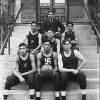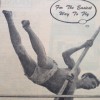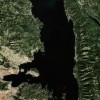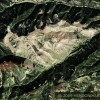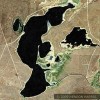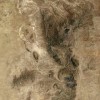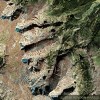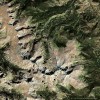
Ancient Asian Saddle Styles in North America (From the Gymnastic Pommel Horse Apparatus To The Native America Saddle)
Posted on Sunday, October 17th, 2010
Asiatic saddle styles (pommels and crupper and breast strapping) appearing in North America as saddles for Native Americans seem to indicate that there are links between the ancient horsemen of Central Asia and the native horsemen of North America.
One of the most exciting gymnastic events is the pommel horse exercise. Because it is now so dramatic it’s easy to forget its origins. Yet it has a lot in common with other sporting events that are equally entertaining. Those sporting events are equestrian vaulting and trick riding on moving horses.
It is well documented that tribal cultures from Northern and Central Asia as well as Native Americans were expert horsemen capable of doing amazing things on horseback. One of these feats is performed by trick riders today and it’s called The Apache Hideaway. This exercise allows the rider to disappear on the far side of the horse making the horse appear riderless. This move can be completed on a galloping horse as well as one that’s stationary.
It’s my belief that the Pommel Horse exercise goes back as far as Genghis Khan and the Mongolian Empire if not before. I believe they may or may not have used stationery pommel horses then because they were using these exercises in real time as cavalry on galloping horses on actual battlefields. These same exercises were later rehearsed on stationery horse models for simplicity. Renatus Vegetius was the first writer to “describe soldiers using a wooden horse for practice”. That original mention was 600 years ago which would make it the 15th Century. However could it have originally occurred much earlier?
Fortunately for those of us interested in Asian history and the use of the horse and saddle equipment and style in Asian culture and warfare there is a large and growing body of research to study. From prehistory to the beginning of the 20th Century the horse was a primary means of transportation and a key component in land warfare. The use of the horse in the earliest civilizations and warfare was to pull chariots. Some have theorized that the tribesmen of Central and North Asia were the first to “Ride Astride”. Chauncey S. Goodrich has done an informative job of writing on this topic as well as another excellent article “The Saddles of the Bronze Horses of Lei-t’ai” (1) “Riding Astride, The Saddle in Ancient China and (2) “The Saddles of the Bronze Horses of Lei-t’ai). One of the mysteries that puzzled Dr. Goodrich was that the ancient Chinese writing on the topic of early Chinese saddles and saddle strapping used the same Chinese words used for chariot harnesses in describing the early saddle equipment. I believe that this may not be as confusing as it may initially appear. Could it be that the reason the same word was used was because the ancient Chinese incorporated the chariot harness into their original saddle and it remained a part of the Asian saddle from that time on? That would explain the breast strap and the rear strapping (“crupper”) that was later immortalized on the Tang Dynasty style horse. It’s hard to find a Tang Dynasty style horse without that strapping. In fact not just the huge Fergana horses captured by Emperor Wu-ti (145-87 BC) used as the Tang Dynasty style models but also working Asian smaller horses had the same “harness strapping” saddle. Asians seemed to consistently maintain that style of saddle decorating. Then why is it that this unique style of Asian saddle strapping shows up on Native American saddles?
- Native American Saddlery and Trappings by J.K. Oliver (Pommels, Breast & Crupper Straps)
- Native American Saddles with Pommels & Crupper & Breast Straps (Three Native American Saddles at the Denver Museum of Nature and Science)
- Another Native American Saddle with High Pommels
- The Harris Horse (Fergana style) in Wyoming with High Asian Saddle Pommels, Stirrup, Crupper Strap and Groomed Asian Style Horse Tail typical of the Tang Dynasty style.
Asian saddles had pommels almost from the very beginning when the horsemen of Central and Northern China developed the first saddles with saddle trees (framed foundations). These pommels had a practical purpose. That purpose is illustrated by the pommel horse exercise. From the saddle used in the Mongol conquest of the largest contiguous empire in the history of mankind and continuing thereafter one of the effective tools used was the Asian saddle pommel which enabled the Mongol cavalry archer to reverse his position on the back of a galloping horse and thus greatly increase his accurate line of archery. The Mongols were known for their effective use of the horses back as a killing platform against often seemingly overwhelming opposition. Their horses were trained to travel long range (up to 120 miles daily) and to survive on minimal amounts of food and water. Advance units of Mongol cavalry archers went behind enemy lines to perform the necessary intelligence prior to their eventual mass invasions. This required them to be even better horseback riders and the best archers possible. They used their saddle pommels to increase their horseback fighting ability and this helped them be the ruthless and practically unstoppable fighting force that Genghis Khan (1162-1227) CE used to conquer his empire.
It’s my belief that the pommel horse exercise was used first by Asians and then later by other cavalrymen to practice rapid mounts, dismounts and other horseback movements. What other explanation can there be for the recorded use of the pommel horse exercise by ancient horsemen? The importance of these techniques was demonstrated by Cambyses, the King of Persia in 522 BCE who mortally wounded himself when mounting his horse.
It is amazing how closely the pommels (the pommel and cantle) on ancient Asian saddles resemble the pommel handles (rings) on the pommel horse apparatus. I am mentioning this because similar Asian like saddle pommels also appear on the saddles of Native Americans.
These Asiatic saddle styles (the pommels and crupper) appearing in North America as saddles for Native Americans seems to indicate that there were indeed direct links between the ancient horsemen of Central Asia and the horsemen of North America.
Ancient Asian Saddles
Tang Dynasty Style Horses
Notice the Breast Straps and Crupper Straps (Also Appears on Many Native American Saddles)
Asian Cavalry
- Tibetan Armed Cavalryman (Appears to have Crupper)
- Chinese Ancient Archer (See Crupper on Horse)
- Mongolian Cavalryman (See Crupper)
- Warring States Cavalryman (Crupper)
- Horsemen Astride Horses (Cruppers)
- Dismounted Cavalryman and Horse (Crupper)
- The Qianlong Emperor on Horseback
- Ottoman Cavalry Using Asian Saddle Trappings
Additional Sources
- Saddle (Wikipedia)
- The Stirrup And Its Effect on Chinese Military History by Prof. Albert Dien
- Stirrup (Wikipedia)
- The Golden Horses of Turkmenistan by Jonathan Maslow
- Cavalry and horses of Northern Wei-China nomadic rulers Dario caballeros
- Gordon’s Corner of Arts & Ancient Chinese Horses *Please pay particular attention to the 6 horses
mentioned in the middle paragraph of Page 5 of 8. These horses most closely resemble The Harris Horse in Wyoming and may have been created in the same time period*
     The Tribute to the Horse from the Book of Job
Chapter 39Â Verses 19 – 24
………………..He swalloweth the ground with fierceness and rage.”
The Beak of the 10th Sun Raven STILL GLOWS!
